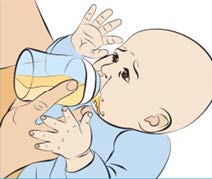There are many ways to bond with your baby while feeding. Hold your baby close, look into their eyes, or softly talk or sing to them. Enjoy your time together.
Choosing how to feed your baby is important. Visit our Parents webpage for more information on topics such as paced bottle feeding, preparing formula, storing formula, expressing and storing breast milk, and more.
Breastfeeding Tip: If you plan to continue offering breastmilk, it is important to breastfeed or express milk every 2-3 hours to maintain your milk supply.
How often should I feed my baby?
Feed your newborn baby 8 or more times each day. As your baby grows, they will show you signs when they need to be fed. These signs are called hunger cues. Learning to recognize your baby’s early hunger cues (see image 1) can reduce their need to cry. Responding early helps your baby fell cared for and makes feeding calmer.
How long should feeding take?
Every baby is different, and each feeding can be different too. Look for signs that your baby is hungry and let them decide how much and how fast to feed. Your baby should look relaxed while feeding. Use paced bottle feeding to keep your baby comfortable and safe. Paced bottle feeding helps your baby drink more slowly and take breaks more easily. To learn more, visit our website.
Keep your baby safe by watching for signs of distress (see image 2) to prevent choking and overfeeding. Stop feeding your baby when they show these signs and slow the feeding down when you restart.
Your baby will also show you when they are full. Signs of fullness include, closing their mouth, pushing away, falling asleep, or turning away.
Image 1: "I am ready to eat"

EARLY HUNGER CUES:
Turning head toward you and opening mouth, moving arms, sticking tongue out, soft sounds.
Image 2: "Please slow down"

SIGNS OF DISTRESS:
Stressed look, stiffening arm/legs, gagging, milk spilling out of mouth, trying to catch their breath.
Amount of Formula to Prepare Each Day
| Baby's Age | Amount of formula in each bottle | Numbers of bottles each day | Amount of formula to prepare each day |
|---|---|---|---|
| Birth - 7 days | Watch for feeding cues. Your baby will drink small amounts at a time. Aim for at least 8 feeds a day. Bottles should contain between 1–2 oz (30–60 mL) |
||
| 1 - 2 weeks | 2–3 oz or 60–90 mL | 6 - 10 | 15–26 oz or 450–780 mL |
| 3 - 8 weeks | 3–5 oz or 90–150 mL | 6 - 8 | 18–35 oz or 540–1050 mL |
| 2 - 5 months | 4–6 oz or 120–180 mL | 5 - 7 | 22–39 oz or 600–1170 mL |
| Solid Foods: Offer your baby other foods around 6 months. For more information, visit wechu.org/parents | |||
| 6 - 8 months | 4–8 oz or 177–240 mL | 4 - 5 | 17–37 oz or 510–1110 mL |
| 9 - 12 months | 6–8 oz or 180–240 mL | 3 - 4 | 10–33 oz or 300–980 mL |
Most babies do not need formula after 12 months. Discuss your baby’s needs with their doctor/nurse practitioner (NP).
* The amount of formula to prepare will vary if you are also providing breastmilk. This table shows approximate amounts to prepare each day. Your baby should guide how much you offer. If your baby is hungry after feeds, add ½ ounce (15 mL) per feed. If you have questions about feeding your baby, talk with your baby’s doctor/NP or call 811.
The Windsor-Essex County Health Unit does not endorse any feeding product or company. This resource does not replace medical advice.
References and Acknowledgements: Illustrations provided by Health Nexxus and used with permission. Dietitians of Canada (2018) Infant Formula: Amount to Prepare Calculations informed formula table.
Infant Forumla Recalls
Safety concerns with formula and baby products are posted on the website recalls-rappels.canada.ca.
Consider subscribing to be notified about new recalls.

